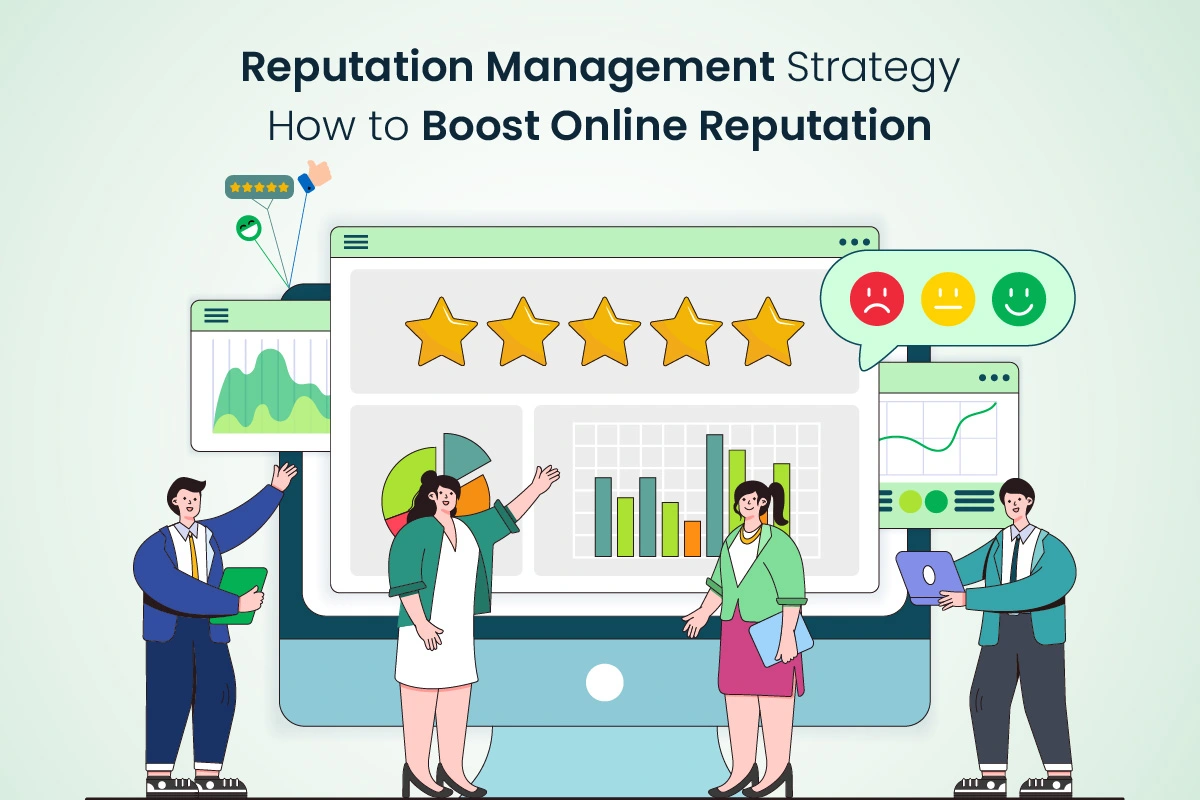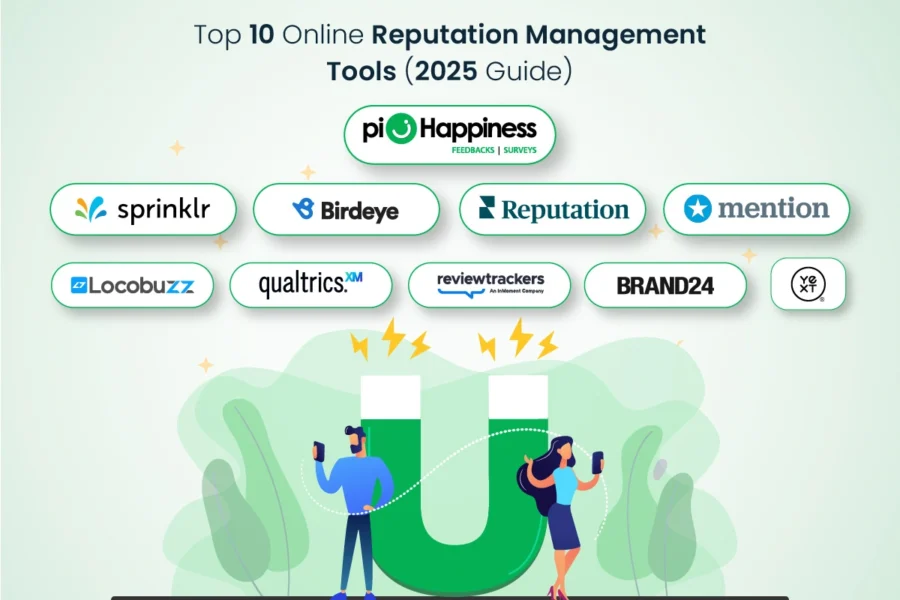In simple words, reputation management means looking after how people perceive your brand, especially online. It’s about shaping and maintaining the image your business has in the minds of customers, potential buyers, and even competitors.
Years ago, a few negative comments here and there might not have done much harm. But now, with more people researching online before making a decision, your online reputation can either make or break your business.
With the help of a strong reputation management strategy, your business looks trustworthy. On the other hand, a poor online brand reputation, even based on a few bad reviews, can raise doubts in the minds of customers.
So, why is reputation management important today more than ever?
- It influences buying decisions: Most people check online reviews before they even consider purchasing from a brand. A positive image builds confidence, while a lack of presence or too many negative comments can push potential customers away.
- It helps attract and retain customers: In the case of good reputation, more customers will want to buy from you. Existing customers are more likely to stay. And in some cases, you might even attract customers from your competitors just because they trust your brand more.
- It builds trust and credibility: People trust brands that are open, responsive, and consistent in what they do and speak. Whether it’s replying to a complaint or sharing a success story, every interaction adds to your brand’s credibility.
- It gives your business a competitive edge: In competitive industries, your reputation can be the deciding factor for customers choosing between you and someone else.
- It helps you bounce back from setbacks: Every business faces tough times or unhappy customers now and then. But if you’ve built a solid reputation, people are more likely to give you the benefit of doubt.
Top 6 best reputation management strategies
Below are the top 6 simple yet powerful strategies you can follow to build and protect your brand’s online reputation.
1. Monitor your current online reputation
Before you make any changes or plans, you need to know where you stand. A common mistake many businesses make is assuming they have a good online reputation without actually checking.
That is why reputation audit is important.
Ask yourself: What do people see when they Google my brand?
Here’s what you should do to monitor your reputation and plan your reputation management strategy:
- Search your brand name on Google: See what comes up—your website, reviews, articles, forum discussions, blog posts, etc. Pay special attention to the first page of search results, as most people don’t go beyond that.
- Check your online ratings and reviews: Go through platforms like Google Reviews, Trustpilot, Facebook, Yelp, or industry-specific review sites. Look for patterns in customer feedback. Are there recurring complaints? Are people generally happy?
- Look for negative content or PR: Sometimes, you may not even realize that there’s a negative article, comment, or review that’s harming your image. Find out if any blogs, Reddit threads, or news sites are talking about your brand negatively.
- Set up alerts: Use free tools like Google Alerts to get notified every time someone mentions your brand online. This gives you real-time updates and helps you act fast if something negative shows up.
Monitoring your reputation gives you clarity. Once you know what people are saying, you can start taking action to improve, engage, or even correct the narrative.
2. Update your social profiles and listings
Once you have a sense of your current brand reputation, the next step is to make sure everything about your brand looks professional and up to date, especially on your social media pages and business listings.
Why? Because your social profiles are often the first point of contact for potential customers. And outdated or incomplete information can instantly make your brand look careless or inactive.
Whether it’s your Google Business Profile, Facebook page, Instagram, or LinkedIn—fill out every field. That includes:
- Business name
- Address and location (if relevant)
- Contact numbers
- Website link
- Business hours
- Services you offer
- Short business description
Make sure all the information is accurate and consistent across platforms. Mismatched details can confuse customers and harm your credibility. Upload your brand logo, cover image, and photos of your business, products, team, or customers (with permission).
When writing your business bio or description, use relevant keywords that describe your services. This helps improve search visibility. For example, if you run a salon in Delhi, phrases like “Delhi hair salon” or “bridal makeup services in Delhi” will help you appear in local searches.
3. Respond to reviews
You’ve probably heard of this reputation management strategy before. However, let’s be clear: responding to reviews is not just good etiquette; it’s a reputation-building tool. Whether it’s a 5-star or a 1-star comment, how you respond says a lot about your brand.
Many businesses either reply only to positive reviews or completely ignore all reviews thinking it’s not worth their time. But in today’s digital world, potential customers often read your replies just as closely as the reviews themselves.
So, why does it matter? It shows that you care. It builds trust with future customers.
Here’s how to do it right:
- For positive reviews:
Thank the customer and mention something specific if possible. Personalize it instead of copy-pasting the same reply everywhere.
Example:
Thanks so much for your kind words, (name)! We’re thrilled to hear you enjoyed our weekend brunch. Hope to see you again soon!
- For average or neutral reviews:
Appreciate the feedback and ask what could have been better. It gives you insights while also showing that you value honesty.
Example:
Thanks for the feedback, (name)! We’d love to know what we could improve to make your next visit even better.
- For negative reviews:
Stay calm. Don’t get defensive. Apologize sincerely, offer a solution, and invite them to continue the conversation offline.
Example:
Hi (name), we’re really sorry to hear about your experience. This isn’t the standard we aim for. Could you share more details with us at (email/phone)? We’d like to make it right.
If you are getting a large number of reviews, consider using a reputation management platform to send automated replies. However, make sure the responses don’t sound robotic. You can still personalize them using smart templates that auto-fill names or review content.
4. Do not ignore negative reviews
No one likes getting negative feedback. However, negative reviews aren’t always a bad thing. In fact, how you respond to them can make a bigger impression than the review itself.
Many businesses either ignore bad reviews or try to bury them under paid ads or fake positive ratings. That never works in the long run. Instead, the most effective approach is to acknowledge, respond, and improve.
Why you should never ignore negative reviews:
- They affect your brand image
- They’re an opportunity to learn
- They can be turned into a positive
While handling negative reviews:
- Never argue or respond emotionally, even if the review feels unfair. Your reply isn’t just for the reviewer, it’s for everyone else reading it too.
- Even if the complaint seems exaggerated, acknowledge the issue and show empathy.
- If you can resolve the issue, say so. Provide a contact number or email and ask them to connect offline.
- If you do resolve the issue, politely ask if they’d be willing to update their review. Many customers are happy to do so if they feel heard.
5. Track and respond to social media brand mentions and tags
People talk about brands all the time on social media and not always by tagging them directly. That means your brand might be getting attention (positive or negative) that you are completely unaware of. That’s why tracking and responding to social media mentions is a crucial part of any reputation management strategy.
If you want to stay on top of brand mentions:
- Use monitoring tools: Free tools like Google Alerts and TweetDeck, or more advanced platforms like Brand24, Mention, or Sprout Social, can help you keep track of where your brand is being mentioned—even if you’re not tagged directly.
- Search for your brand regularly: On platforms like Twitter (X), Instagram, and Reddit, just search your brand name every few days. Look for variations and common misspellings too.
- Check tagged photos and stories: Especially on Instagram and Facebook, people often tag businesses in their posts and stories. Make it a habit to check your notifications and respond when appropriate.
6. Paid campaigns
While organic efforts like responding to reviews and optimizing profiles are essential, paid campaigns give you more control over how people perceive your brand. Think of them as a fast way to amplify your strengths and shift the narrative in your favor.
Unlike organic content, paid campaigns let you decide exactly what people see such as your best reviews, your mission, your happy customers, or new updates. Instead of waiting for people to find your brand, you can directly reach thousands of potential customers in your target audience with a well-designed campaign.
You can showcase your company values, quality of service, customer satisfaction ratings, community work, or success stories. These messages can have a huge positive impact on how people view your brand.
Wrapping up
At the end of the day, your reputation is your brand’s most valuable asset. It’s what customers remember, what they share with others, and what ultimately drives business growth or holds it back.
Reputation management doesn’t have to be overwhelming. Know what people are saying about you. Stay active and updated online. Respond with empathy and professionalism. Own your mistakes and fix them. Share the good stories proudly.
It’s not about being perfect. It’s about being present, consistent, and real.
With piHappiness, you can monitor reviews and build a strong reputation, all from one easy-to-use reputation management solution.
Book a demo to see how piHappiness can help you stay ahead of the conversation.







